All About AbbVie: A map for Selling to AbbVie
September 30, 2020 | Xhermi Trimi |
Industry Articles
Note: This article was originally written for 2019 publication, and has since been updated.
AbbVie is an American researched-based biopharmaceutical company, founded in 2013 as a spinoff from Abbott Laboratories. Abbott Laboratories now specializes in medical devices, diagnostic equipment, and nutrition products, whereas the separate entity, AbbVie, operates as a research-based pharmaceutical manufacturer. This is thought to have been a move to protect the value of the medical devices business, in anticipation of the upcoming patent expiration for their top-selling pharmaceutical product, Humira.
Since its inception, business has been steadily growing at AbbVie. They ranked 7th on Pharm Exec’s 2019 list of top-earning pharmaceutical companies (based on 2018 sales), up one spot compared to the previous year [1]. Pharmaceutical sales came up to about $32.7B and 25% of global sales were generated from new products that have launched since 2013. Performance in 2018 was AbbVie’s strongest to date, according to the company Annual Report [2]. Earlier this year, AbbVie acquired Allergan for $63B USD [3]. This merger will likely lead to an even higher ranking for AbbVie on Pharm Exec’s 2020 list.
Business Overview
At the end of 2018, AbbVie had approximately 30,000 employees internationally. AbbVie products are marketed in over 170 countries, worldwide. Their key therapeutic areas are Immunology, Oncology and Neuroscience. Their products span several disease areas including: rheumatology, gastroenterology, dermatology, oncology, virology (HCV and HIV), Parkinson’s disease, thyroid disease, complications associated with cystic fibrosis and pain associated with endometriosis. AbbVie’s most popular products are listed in Table 1 below.
AbbVie has launched 15 new products or indications since its inception and continues to develop their pipeline [2]. The company uses integrated discovery and development project teams, which include chemists, biologists, physicians and pharmacologists as well as third party companies for their research and development (R&D) efforts. In 2018, they invested $5.1B in R&D and their pipeline currently includes 43 new compounds (8 in immunology, 24 in oncology, 7 in neuroscience, 2 in virology, and 2 in general medicine) [14]. There are currently 208 active clinical trials being sponsored by AbbVie, 41 of which have been registered in the previous 12 months. Their pipeline includes 66 Phase 1 programs, 45 Phase 2 programs, and 81 Phase 3 programs.
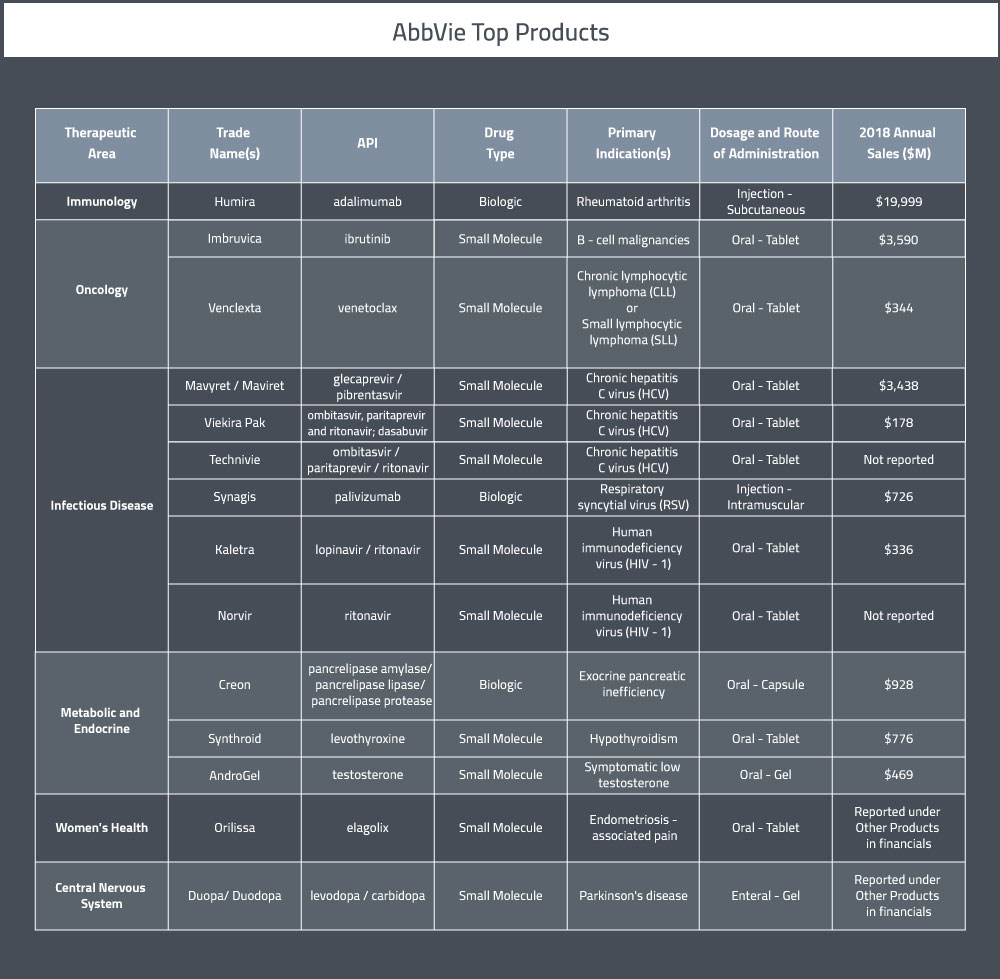
Outsourcing History
Manufacturing
AbbVie has several existing agreements with various third party companies for functions such as process development, product distribution, analytical services and manufacturing. For some of its products, AbbVie contracts out functions such as formulation & development, fill & finish, packaging, transportation & distribution, and logistics services. Additionally, AbbVie procures many of its active pharmaceutical ingredients from third parties. In most cases, AbbVie maintains alternate supply relationships so that their business is not dependent on any individual agreement. They also maintain product inventory to minimize the impact of any supply disruption. In addition to these varied contracts and arrangements, AbbVie also offers its own contract manufacturing services through its AbbVie Contract Manufacturing business [4].
Have a Zymewire account? Click here to view AbbVie's global activity!
R&D and Commercialization
In addition to developing and marketing its own independent products, AbbVie also frequently enters into development and commercialization agreements with third parties. These agreements include licensing arrangements, option-to-license arrangements, strategic alliances, co-promotion arrangements, co-development and co-marketing agreements, and joint ventures. The arrangements usually include upfront license fees, option fees/exercise payments, milestone payments and royalty and/or profit sharing obligations.
In 2016, AbbVie signed a discovery collaboration and licensing agreement with CytomX to discover and develop oncology candidates using their therapeutic technology platform [5]. This agreement led to two global co-development and licensing agreements, based on promising candidates identified. Similarly, in 2018, they entered into an exclusive strategic collaboration with Voyager Therapeutics Inc. for the development and commercialization of antibodies for the treatment of Alzheimer’s disease [6]. This arrangement also included an option agreement.
In recent years, AbbVie has entered into many similar development/commercialization agreements with biotechnology companies. Lately, the company has been focussing on partners that specialize in novel oncology therapies and treatments for neurological disorders. Recently partners in the field of oncology have been Lupin Limited [7], Tizona Therapeutics Inc [8], Teneobio [9]. Their neurological disease partnerships have included BioArctic for a Parkinson’s [10], and Mission Therapeutics for Parkinson’s and Alzheimer’s [11].
Want to learn what AbbVie and other big pharma companies are spending on R&D? Check out our free report on Outsourcing Pharma!
Drug Development Sites
AbbVie’s corporate headquarters are located in North Chicago, Illinois. Inside the United States, they have several manufacturing facilities. Specifically, in Abbott Park (Illinois), North Chicago (Illinois), Worcester (Massachusetts) and Wyandotte (Michigan). They also have one distribution center in the United States and R&D facilities in Abbott Park (Illinois), North Chicago (Illinois), Redwood City (California), Cambridge (Massachusetts) and Worcester (Massachusetts).
Outside of the United States, AbbVie owns and operates manufacturing facilities in Barceloneta (Puerto Rico), Jayuya (Puerto Rico), Campoverde di Aprilia (Italy), Cork (Ireland), Ludwigshafen (Germany), Singapore (Singapore) and Sligo (Ireland). They also operate other manufacturing facilities worldwide.
Their principal R&D facilities outside of the United States are located in Ludwigshafen, Germany and Tokyo, Japan.
Update: There may be some shifting of development and operational sites following the 2019 acquisition of Allergan.
-1.jpg)
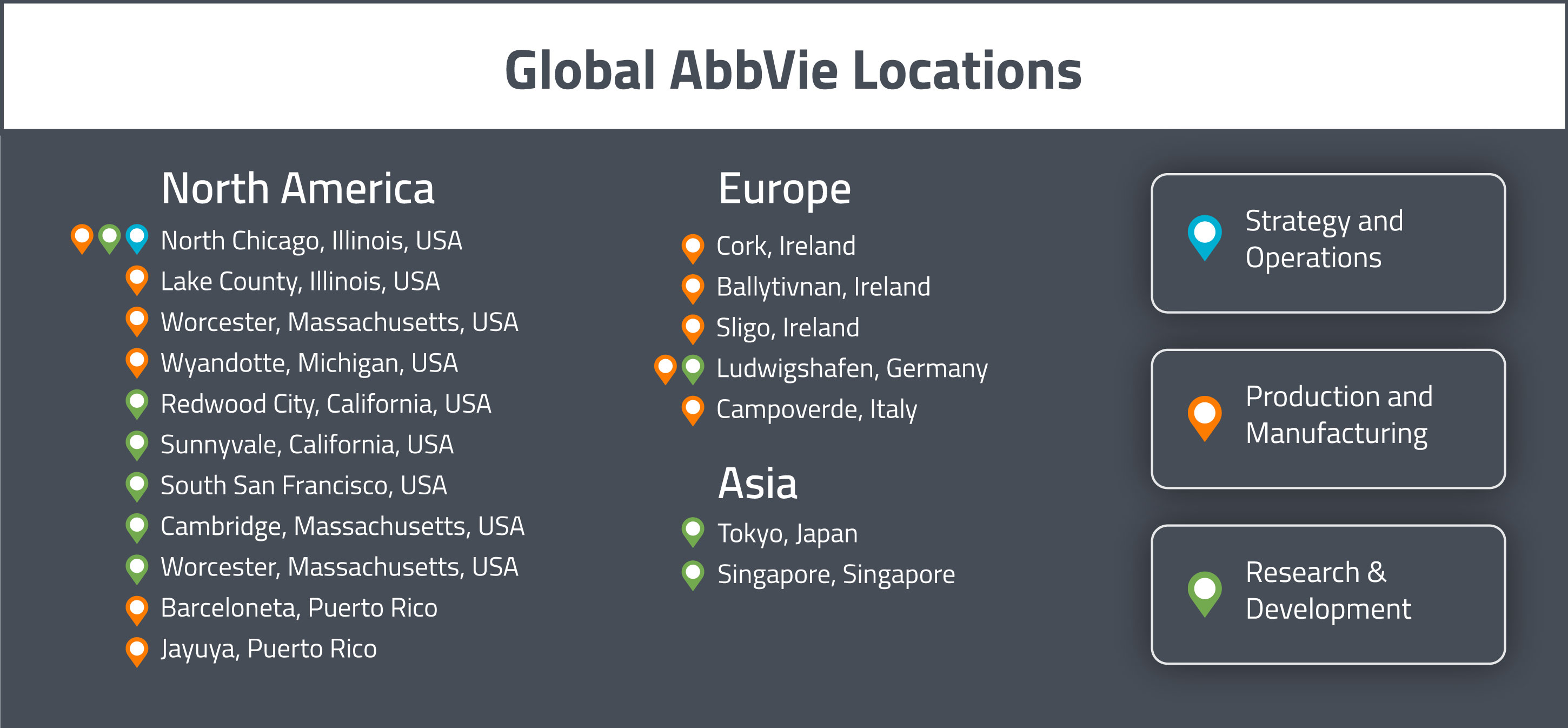
Decision Making
Decision making has been classified into three sections: clinical outsourcing, manufacturing and logistics. This division should facilitate outreach efforts by different types of companies looking to conduct business with AbbVie.
Where are their clinical outsourcing decisions based out of?
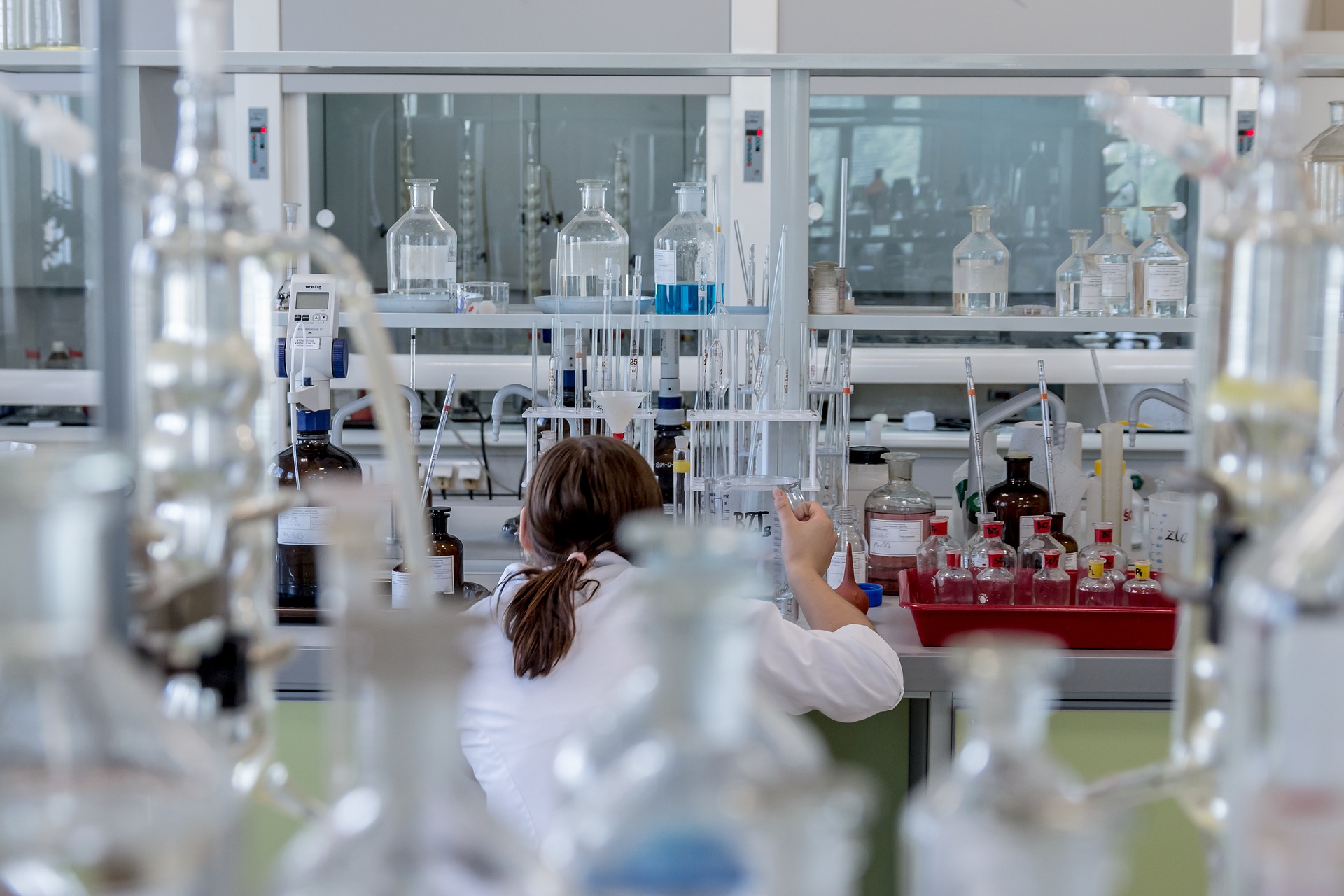
The majority of North American clinical decision making for AbbVie takes place in the United States. One of the main locations in the United States is North Chicago (IL, USA). In North Chicago, there are multiple Clinical Outsourcing Project Managers, there is also a Director of Clinical Development, a Vice President of Clinical Development, a Director of Clinical Contracting and a Director of Clinical Operations. Elsewhere in the United States, there are also Directors of Clinical Operations—specifically, in Redwood City (CA, USA) and the San Francisco Bay Area (CA, USA).
Clinical decision making for Europe is more dispersed. It appears to be split across Germany, Spain, Belgium and the United Kingdom. In Ludwigshafen (Germany), there are multiple Clinical Operations Managers and there is an Outsourcing Manager. In Madrid (Spain), there is a Director of Clinical Development and in Antwerp (Belgium), there is a Director of Clinical Operations. Finally, in Maidenhead (United Kingdom), there is a Director of Clinical Trials.
Clinical decision making for APAC is spread across China, Japan, Australia and Singapore. There is a Head of Chinese Clinical Development in Shanghai (China). There are multiple Clinical Project Managers in Tokyo (Japan). There is a Clinical Operations Manager in Adelaide (Australia) and there are multiple Clinical Operations Managers in Sydney (Australia). Finally, there is a Clinical Operations Manager in Singapore (Singapore).
Where are their manufacturing decisions based out of?
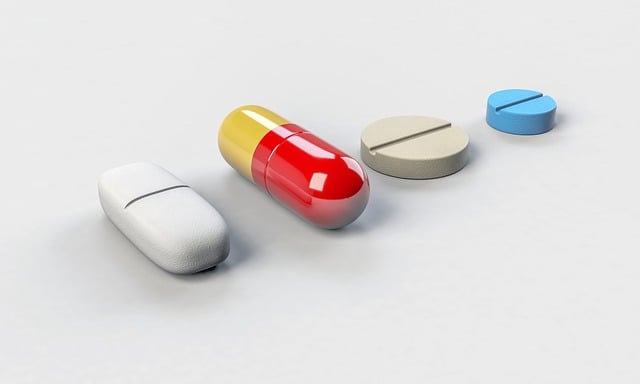
Manufacturing decisions for North America are mostly split across the United States and Puerto Rico. In the United States, there is a Director of Manufacturing and a Director of Product Development in North Chicago (IL, USA). There are also multiple Directors of Biologics Manufacturing in the Greater Boston Area (MA, USA). In Puerto Rico, there is a Director of Biologics Manufacturing. Interestingly, the Vice President of Regional Manufacturing for USA and Puerto Rico is based out of Europe in Luswigshafen, Germany.
European manufacturing decisions are made in Germany, Italy and Ireland. In Germany, there is a Vice President of Manufacturing Operations, a Head of Clinical Supply Manufacturing and Third Party Manufacturing Manager in Ludwigshafen. In Italy, there is a Drug Product Manufacturing Director, a Formulation Manufacturing Manager and a Finished Goods Manufacturing Manager in Campoverde. Finally, in Ireland, there is an API Manufacturing Manager, a Vice President of Biologics Manufacturing and a Third Party Manufacturing Manager in Sligo.
Manufacturing decisions for APAC are based out of Singapore and India. In Singapore, there is a Director of Biological Manufacturing, a Third Party Manufacturing Manager and an API Manufacturing Director. In India, there is an External Manufacturing Manager in the Chandigarh Area.
Where are their logistics operations based out of?
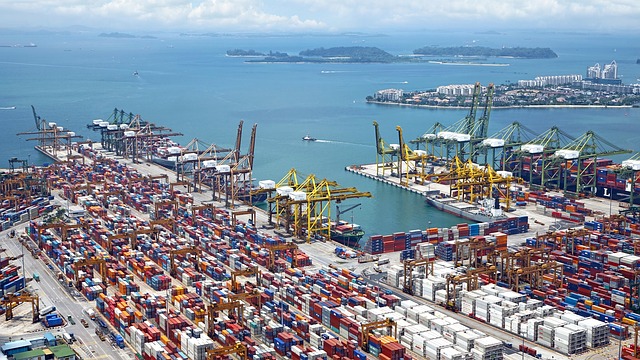
Logistics decision making for North America takes place in the North Chicago (IL, USA). That’s where you’ll see titles such as Director of Outsourcing Strategy, Outsourcing Supplier Manager, Director of Clinical Supply Management, Director of Global Sourcing, Director of Supply Chain and Director of Non-Clinical Outsourcing Contract Management. There, you’ll also find multiple Directors of Sourcing.
Logistics decisions for Europe are very dispersed. There are European logistics decision makers in Ireland, Germany, Netherlands, Sweden, the United Kingdom and Belgium. In Cork and Sligo (Ireland), there is a Purchasing and Logistics Manager and multiple Supply Chain Managers. In Cork there is also an EMEA Strategic Sourcing Manager. In Ludwidshafen (Germany), there are multiple Senior Sourcing Managers and there is a Director of Clinical Drug Supply Chain. In the Zwolle Area of Netherlands, there is a Distribution and Logistics Manager and there are multiple Supply Chain Managers. In the Almere Stad Area, there is an EMEA Logistics and Distribution Manager. Finally, in the Amsterdam Area, there is a Procurement Manager. Elsewhere in Europe, there is a Demand and Logistics Manager in Stockholm (Sweden), there are multiple Procurement Managers in Maidenhead (United Kingdom) and there are multiple Senior Sourcing Managers in Brussels (Belgium).
Logistics decisions for APAC are very dispersed. There are APAC decision makers in Saudi Arabia, India, Israel, Japan, Australia and China. In Saudi Arabia, there is a Supply Chain Manager and a Director of Supply Chain. In India (Mumbai Area) and in Israel (Hod Hasharon), there are multiple Supply Chain Managers. In Japan (Tokyo), there is a Group Manager of Supply Chain Management. In Australia (Sydney), there is a Procurement Lead and in China (Shanghai), there is a Category Manager.
Have a Zymewire account? Click here to view AbbVie's global activity!
Innovation
One of the main ways AbbVie fosters innovation internationally is through its Open Innovation Programs [12]. Through these programs, they foster relationships with academic partners, industrial partners, government organizations and non-profit organizations in order to foster innovation. Its first program is their Compound Toolbox program, through which they licence proprietary research compounds to researchers exploring specific targets, pathways and assays. In their second program, Open Innovation Concepts, they accept collaboration invitations from investigators in areas of interest to Abbie (oncology, neuroscience, virology, immunology).
In the United States, AbbVie further fosters innovation through their AbbVie Innovation Center in Research Park at the University of Illinois. This facility employs undergraduate and graduate students part-time throughout the year to work on projects related to AbbVie’s therapeutic areas of expertise [13]. They also have multiple state-of-the-art research facilities located near traditional Life Science hubs in the United States: three facilities in California (Redwood City, Sunnyvale and South San Francisco) and one in Cambridge, Massachusetts.
Where can I find more information like this?
If you would like a simple solution for keeping an eye on drug sponsor companies, such as AbbVie, without relying on a database and generic lists of leads each week, we at Zymewire are here to help. Reach out today, and stay tuned for the next instalment of Sponsor Atlas: Selling to the Pharma Giants. If you enjoy these articles, please feel free to give them a share!
To view Part 7 of the Sponsor Atlas series, Mapping Merck: A map for Selling to Merck & Co., click here!





.png?width=500&name=Q3%202024%20Biopharma%20Recap%20(Zymewire).png)

Comments